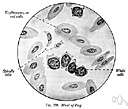


This is likely because they are from a similar root or common origin.

You may notice that some of these translations look very similar to the word affinity. Words that mean affinity can also be found in many other languages. This can also refer to keeping a task running on the same processor in a symmetric multiprocessing operating system to reduce the frequency of cache misses. In chemistry, this can refer to the force by which chemical compounds and chemicals are held together by each receptor, according to Dictionary. Someone can measure to the degree of interaction their close similarity. For example, a prehistoric man might have structural resemblances to the biological populations of different animals based on their taxonomy – they may even contain a similar hormone, antibodies or antigen. In biology, this refers to the resemblance in the structural parts of a group of organisms or particles, or the similarity of the essential structural parts or anatomical structure that creates a phylogenetic relationship. Affinity is four syllables – af-fin-i-ty, and the pronunciation of affinity is əˈfɪnɪtɪ. It can also refer to a family relationship through marriage of a relative, or through adoption. The suffix -ties can be added to the end of the word affinity to form the plural affinities. According to Dictionary and the American Heritage Dictionary of the English Language, the word affinity is a noun that means a tendency to have a natural liking,an attractive force, inclination, or natural attraction to someone or something.


 0 kommentar(er)
0 kommentar(er)
